CT and navigation yield high accuracy for pedicle screw placement in children
Investigators found that malposition rates increased in the mid-thoracic spine.
Researchers from the University of Minnesota found 96.4% accuracy using intraoperative CT and 3-D image-guided navigation for pedicle screw placement in pediatric patients with spinal deformities.
“We find this to be a useful tool,” study investigator David W. Polly Jr., MD, said during his presentation at presented at the American Academy of Orthopaedic Surgeons 2012 Annual Meeting. “It can custom-fit screws to the pedicle tract, especially in significantly aberrant anatomy, whether it is congenital scoliosis or revision surgery. We found a higher rate of malposition at the mid-thoracic spine. [There] is a higher rate of malposition in children than adults. […] Our accuracy has improved compared to what the literature currently states, and we have had no returns to the operating room for implant malposition.”
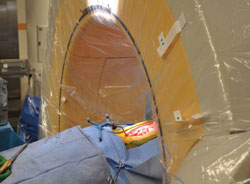
Pictured is the O-arm spinning. The blue reference frame, or calibration frame, is firmly clamped to a spinous process. This cannot move during the case, or the 3-D images will become inaccurate.
Images: Polly DW
CT and image-guided navigation
In their retrospective review, Polly and colleagues studied the accuracy of nearly 1,000 open pedicle screws placed in 50 pediatric patients in using an intraoperative CT (O-arm, Medtronic Inc., Louisville, Colo.) and a computerized navigation system (Stealth, Medtronic Inc.). The patients had a mean age of 14.4 years and were diagnosed with idiopathic or neuromuscular scoliosis, Scheuermann’s kyphosis, congenital hemivertebra, acquired kyphotic deformity or thoracic instability after tumor resection.
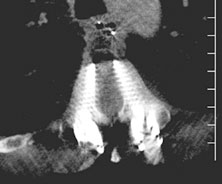
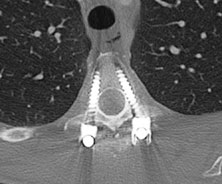
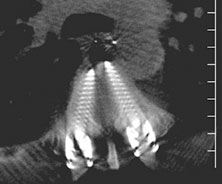
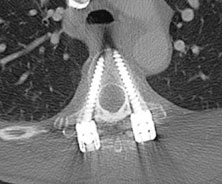
The intraoperative O-arm images with low resolution are shown on the left. The postoperative angiogram CT is shown on the right.
The investigators assessed intraoperative images of the placed screws and the number of screws that were repositioned. Outcome measures included the need for intraoperative redirection and removal of screws. They compared the results to previous reports in the literature and those of 175 adult patients with a total of 1,500 screws placed by the same surgeons using an identical technique.
Accuracy among groups
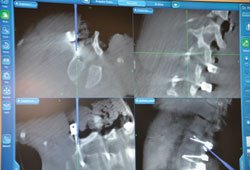
An intraoperative revision of a screw uses navigation.
In the pediatric group, surgeons revised 35 of 984 screws (3.6%). Screws placed in the T4 to T6 range had most frequently needed repositioning (7% to 10% of screws).
“The key point is that once the pedicle diameter gets below about 4 mm, the malposition rate certainly increases,” Polly said. Overall, he noted that no patient returned to the operating room for implant malpositioning during the 5 years this technique has been in use.
The technique showed 98.2% accuracy in the adult group with 28 of 1,511 screws revised for malposition. Polly noted that a meta-analysis published by Kosmopolous and colleagues found 93.7% accuracy in navigated pedicle screw placement in adult patients.
According to manufacturer’ guidelines, one O-arm spin is equivalent to 35 seconds of fluoroscopy time. When they compared this to the fluoroscopy times in the literature, the authors calculated no significant difference in radiation exposure.
Polly added, “Radiation exposure is an issue, and needs further development and discussion.” – by Renee Blisard Buddle
Reference:
- Larson AN, Santos ERG, Polly DW Jr., et al. Pediatric pedicle screw placement using intraoperative CT and 3-D image-guided navigation. Paper #344. Presented at the American Academy of Orthopaedic Surgeons 2012 Annual Meeting. Feb. 7-11. San Francisco.
For more information:
- David W. Polly Jr., MD, can be reached at the Department of Orthopaedic Surgery, University of Minnesota, 2512 South 7th St., Suite R200, Minneapolis, MN 55455; 612-273-8000; email: pollydw@umn.edu.
- Disclosure: Polly has no relevant financial disclosures.
